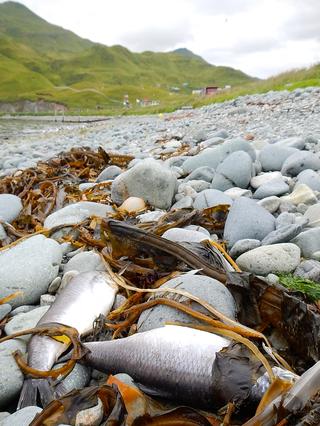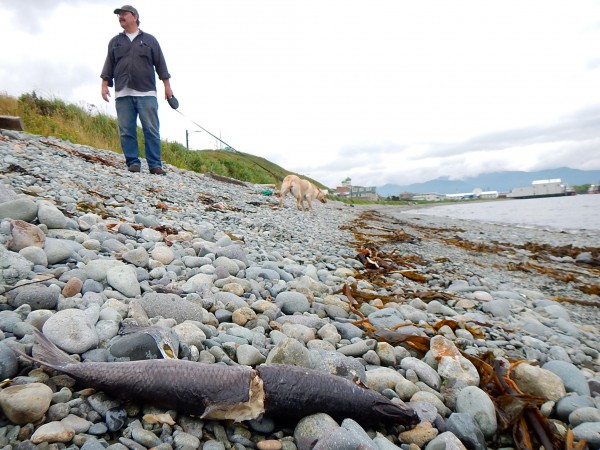
Hundreds of dead herring washed up on Front Beach in downtown Unalaska on Tuesday.
“Hundreds of herring floating in the water,” Caleb Livingston, who lives nearby, said as he was walking his dog Hazel on the beach. “But what really got my attention was the few that drifted on the beach were not being eaten by the eagles, or seagulls or terns.”
Scientists have been receiving reports of dead and dying whales, birds and the small fish known as sand lance in the Aleutian Islands.
A dead Steller’s sea lion washed ashore in Unalaska in July with no wounds or other obvious causes of death.
Researchers think the killer might be toxic algae proliferating in unusually warm ocean waters.
Mussels taken from two different bays in Unalaska this spring have had levels of the toxin that causes paralytic shellfish poisoning two to four times higher than the level considered safe by the U.S. Food and Drug Administration.
Livingston said he doesn’t think the herring he saw on Front Beach were killed by toxic algae.
“I’m guessing that somebody shoveled them off a boat,” he said.
Herring are used as bait by crabbers and longliners.
“Boats shouldn’t do that in close. If they’re going to get rid of this stuff, they should do it further out,” Livingston said. “It’s probably not that harmful, other than critters like Hazel gobbling on it, but it is a form of pollution.”

Scientist Melissa Good with University of Alaska Fairbanks agreed, after a quick bit of beach forensics, that these dead fish were probably dumped in the water.
She said the herring had lost their scales, suggesting the fish had been poured through a chute en masse.
“Their fins are deteriorated while their eyes are intact,” Good said. “I think it’s probably bait fish that got dumped.”
Even so, Good said she will send herring that she and Livingston collected on the beach to an Alaska Department of Environmental Conservation lab for analysis.
This spring, Good collected mussels from Captains Bay and Summer Bay in Unalaska to see if they had the toxin that causes paralytic shellfish poisoning.
She just got the results back: Mussels had up to 3.3 parts per million of the potent PSP toxin. That’s four times higher than the FDA’s 0.8 parts per million limit.
“Anything above that is unsafe to eat,” Good said.
“I would suggest people take caution and probably not harvest mussels or any other clams or bivalves within the Unalaska area because we are seeing high toxin levels for the previous spring months,” she said. “It’s likely these levels are higher now, after the summer algal blooms.”
In an email, Bruce Wright with the Aleutian Pribilof Islands Association said butter clams tested in June at Sand Point, in the Shumagin Islands, just east of the Aleutians, showed even higher levels of the toxin.
One of the largest algal blooms ever recorded has been spreading throughout the Northeast Pacific Ocean, from California to Alaska. Scientists believe a giant blob of warm water is fueling the harmful algal bloom.




